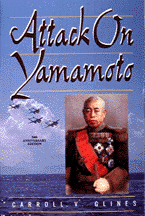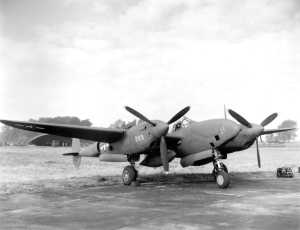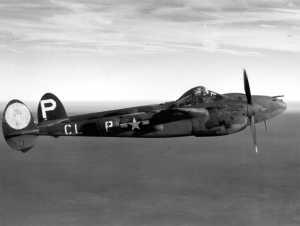Major John W. Mitchell
Leader of Yamamoto Mission
By Stephen Sherman, Oct. 1999. Updated June 29, 2011.
John Mitchell was swatting flies in his tent at Fighter Two when the phone rang, "Get over to the Navy briefing bunker. There's a mission for you and your guys. You'll like it."
Major Mitchell, the CO of the 339th Fighter Squadron, based at Guadalcanal, headed over to the bunker with Tom Lanphier, one of his top pilots, where they met Admiral Marc Mitscher and "every brass hat on the island." It was April 17, 1943.
In the crowded room they looked over a document marked "TOP SECRET", which outlined Admiral Isoroku Yamamoto's schedule for an inspection trip from Rabaul to Bougainville, along with an order signed by United States Navy Secretary Frank Knox:
"SQUADRON 339 P-38 MUST AT ALL COSTS REACH AND DESTROY. PRESIDENT ATTACHES EXTREME IMPORTANCE TO MISSION." The senior Navy and Marine Corps officers took over the discussion, and Mitchell and Lanphier were gradually pushed out to the edge of the group. When the planning bogged down, they were re-invited. All agreed that only U.S. Army Air Force P-38 Lightnings, equipped with drop tanks had the range for the job. Mitchell ruled out any attempt to get Yamamoto during a shipboard leg of his trip, "My men wouldn't know a sub-chaser from a sub. It'll have to be in the air." After more discussion, Admiral Mitscher cut it off, noting that Mitchell and Lanphier would have to work out the details. Extra-large drop tanks had already been ordered; Mitchell wanted a top-quality Navy compass.
The Plan
That evening Mitchell pored over maps of the Solomons with Lanphier and Joe McGuigan, the intelligence officer. They laid out a course that after leaving Guadalcanal, would keep them 50 miles away from the Japanese-held islands of New Georgia, Vella Lavella, and the Treasuries. The planned route from Guadalcanal to the interception point at Bougainville was 400 miles, two hours flight time. Based on their estimates of Yamamoto's air speed (180 MPH) and scheduled arrival at Kahili, they estimated that he would be at the interception point at 9:35AM. The brass had called for "maximum effort" to get Yamamoto; that meant Mitchell would lead 18 P-38 Lightnings on the mission.
Mitchell assembled his men just before midnight to brief them on the raid. All 40 of his pilots had volunteered for the mission. He promptly informed them of the eighteen pilots on the flight teams:
- the shooters or killer group (4) - Tom Lanphier, Rex Barber, McLanahan, and Moore
- the cover group (6) - Mitchell leading, Doug Canning, Jack Jacobson, Frank Holmes, Hine, and Goerke. Holmes and Hine were the alternates for the killer group.
- the second cover group (8) - eight pilots of the 12th Sqn, led by Louis Kittel
As the rain came down on the black hilltop, he explained the risks and uncertainties: missing Yamamoto altogether, new drop tanks being installed that night, running out of fuel, getting jumped by Zeros. They guessed that he would be flying at about 5,000 feet. After the wave top flight, the Lightnings of the killer group would climb to that altitude; the cover group to 20,000. Mitchell emphasized the importance of low level flying and radio silence; he didn't want the Japs to pick up on this mission.
When the meeting broke up, Mitchell walked back to his tent, and lay down. He could hear Glenn Miller's "Serenade in Blue" from Canning's tent.
Background
Maybe he thought about Yamamoto, about Pearl Harbor, about December 7, 1941, when he was with the 70th Pursuit Squadron, stranded near Charlotte, North Carolina, due to a malfunctioning P-40. At that time, John Mitchell was a twenty-six year old from Mississippi, born . He had been valedictorian of his high school class, a student at Columbia University, and was a three year Army veteran. He managed to get married in the confused weeks just after Pearl Harbor, and then shipped out to San Francisco. On his arrival at the 70th FS base at Hamilton Field, he learned that most of the experienced men of the squadron had been sent to Java, to try to stem the Japanese onslaught. (They failed, and most of them died.)
After re-organizing, and training new recruits as well as possible, the 70th FS embarked for Fiji on Jan. 20, 1942. The scuttlebutt was that they wouldn't be there long; the Japs would kick them out soon enough. Keenly aware of their dim prospects, the young pilots lived it up on the ship; as Doug Canning recalled, "We left a trail of hooch bottles all the way from the Golden Gate to Fiji." Landing at the harbor of Suva, the men of the 70th began to struggle with their P-39s in the tropical downpours and mud of Fiji. With the aid of the Bell Aircraft rep, they got the Airacobras into the air and began training in them. They trained intensively with the P-39s for six months, their only diversions being volleyball and high-stakes poker. They thought they were hot pilots and were ready to take on all comers. Then some Navy pilots from Saratoga visited and gave them some insight into real combat, showing them the greater maneuverability of the Wildcat and the technique of the Thach weave. They continued training on Fiji through autumn of 1942, entertaining several dignitaries in these months, notably WWI ace Eddie Rickenbacker - who had survived 24 days at sea on a raft, AAF chief General Hap Arnold, and a young Texas Congressman named Lyndon B. Johnson.
On October 5, Mitchell and eight of his pilots were detached from the 70th for duty on Guadalcanal with the 339th Fighter Squadron. They arrived just in time for the darkest days at Guadalcanal. At one point the Japanese were only 600 feet from their airstrip. The crew chiefs removed the .30 caliber machine guns from some planes, to use in a last-ditch stand. When landing at Henderson Field, the fliers dodged bushes in the runway, held there by brave crewman, to mark the location of shell holes. Several pilots were lost in night landings, due to the dim lights, the frequent storms, and the rough conditions of the strip. Despite flying the inadequate P-39, Mitchell had shot down three Jap planes by early November, and later that month was promoted to Major and CO of the 339th FS.
The arrival of the first P-38 Lightnings overshadowed his promotion. The twin-engined fighters had a top speed of 395 MPH at 25,000 feet and devastating firepower - four .50 caliber machine guns and a 20mm cannon mounted in the nose. Because they could fire straight ahead, rather than in the common converging patterns of wing-mounted guns, they could fire a constant stream of lead that was effective at all ranges up to 1000 yards. The P-38s had some drawbacks: feeble heaters, exhorbitant fuel consumption, and high maintenance (long before Meg Ryan). But the pilots loved the new planes, which inflicted even higher losses on the Japanese.
In December, Tom Lanphier, Rex Barber, Doug Canning, and other pilots of the 70th Squadron came to Guadalcanal, alternating duty with the 339th. Once Canning spotted a Jap freighter in The Slot and arranged a betting pool on which pilot could get the best hit on the ship. He put a 500 lb. bomb through her deck, sank her, and won the pool. In the early part of 1943, the pace of war slackened a little, although Barber and some other 70th pilots sank a destroyer in March.
Back in Hawaii, on April 14, the American code-breakers intercepted the message detailing Yamamoto's itinerary. The decoded and translated message made its way to Washington DC, back to Admiral Nimitz in Hawaii, then Halsey on New Caledonia, and to Mitscher on Guadalcanal. All levels approved the shoot-down mission, and Mitscher assigned it to John Mitchell of the 339th.
The Mission - April 18, 1943
Throughout the wee hours of the morning at Henderson Field, welding torches flamed brilliantly under protective tarpaulins, as the ground crews fitted the large new tanks under the wings of the P-38s. By dawn 18 planes were ready. The pilots ate their usual unsatisfactory breakfast of Spam, dried eggs, and coffee. Mitchell, inwardly doubtful of the mission's chances for success, exuded quiet confidence as he chatted with the fliers and ground crew. His last instructions before the 0700 take-off were to maintain radio silence. The Lightnings roared into life and, before getting airborne, trundled to the end of the runway, being so heavily laden. At take-off McLanahan blew a tire and shortly afterwards Moore's new tanks wouldn't feed. These two 'shooters' dropped out of the mission; Hine and Holmes replaced them.
Mitchell's remaining 16 planes thundered along at wavetop level to avoid Japanese spotters. They sped northwest, sweeping widely away from Jap-occupied New Georgia. Mitchell tried to hold the planes at the dangerously low level of thirty feet; with only the smooth ocean below, depth perception was almost non-existent. Horrified, Mitchell watched helplessly as one plane dipped low enough to kick up spray onto his windows. But the pilot kept control and eased the big fighter back up out of the waves. By 0800, the American raiders were 285 miles from the planned interception; at that minute, Admiral Yamamoto's Betty bomber took off from Rabaul, precisely on time for his scheduled 1000 arrival on Bougainville. His entourage included one other Betty bomber and six Zeros. Yamamoto's chief of staff, Admiral Ugaki, flew in the second bomber.
The sun beat down on the large windows of the Lightnings. Designed for high altitude work, Lockheed had elected not to provide the cockpits with coolers. The pilots sweated profusely in their flying greenhouses and at 0820 changed their heading for the first time, swinging slightly to the north. Half an hour later, when abreast of Vella Lavella, they made their second planned course change, again shifting a little more to the north.
At 0900, Mitchell made their last change, heading northeast, directly toward the coast of Bougainville, only 40 miles away. He also began the slow climb for altitude at this point. The pilots test fired their guns. The minutes ticked away and the Lightnings droned on, climbing as the mountains of Bougainville came into view. 0934 when sharp-eyed Doug Canning called out "Bogeys, eleven o'clock. High." Mitchell couldn't believe it; there they were, right on schedule, exactly as planned. The Japanese planes appeared bright and new-looking to the pilots of the 339th. They jettisoned their drop tanks and bored in for the attack. Holmes and Hine had trouble with their tanks, only Barber and Lanphier of the killer group went after the Japanese bombers. All the other P-38s followed their instructions to fly cover.
The attack itself has been shrouded in uncertainty and, unfortunately, in controversy. Both Lanphier and Barber claimed one bomber shot down over the jungles of Bougainville. Frank Holmes claimed another shot down over the water a few minutes later. From Japanese records and survivors, among them Admiral Ugaki, the following facts are certain. Only two Betty bombers were involved; Yamamoto's was shot down over Bougainville with no survivors; the second went into the ocean and Ugaki lived to tell about it. Shortly after the attack, a Japanese search party located the wreckage, including the Admiral's body, which they ceremonially cremated.
The Lightnings had waded into the Japanese flight, pouring forth their deadly streams of lead. In the manner of all aerial combat, the fight was brief, high-speed, and confused. The individual pilots recorded their impressions for the Air Combat Intelligence officers; it wasn't until long after the war that anyone realized their claims for three bombers had been overstated.
The pilots uneventfully flew back to Guadalcanal, where upon landing, the ground personnel greeted them gleefully, like a winning football team. While Lanphier and Barber briefly disagreed about the air battle, all was subsumed in the generally celebratory atmosphere. Lanphier later recalled enjoying his best meal of the war that night. The controversy has continued down to the present day. Read more about the "Who Shot Yamamoto?" on the Tom Lanphier page.
For Mitchell and the other participants, the war was over. They knew far too much to risk them in front line action. All were promptly sent stateside for training and other assignments. There were among a handful of army fliers to receive the Navy Cross for their achievement. (Although Mitchell later shot down three more planes over Japan, while flying P-51s for the 15th and 21st Fighter Groups.)
Korean War
Mitchell flew again in the Korean War, taking over the 51st FIW for Gabby Gabreski in June, 1952. He shot down 4 MiGs in Korea. Among his other challenges as CO was controlling the "flight suit" mentality of his fliers, who bent all the rules in their desire to "kill MiGs." Things came to a head when Lt. Col. Edwn Heller of the 16th FIS was shot down on the wrong side of the Yalu. As Robert Dorr describes it in Korean War Aces, "Mitchell was madder than any colonel the pilot had ever seen." Mitchell and General Barcus made a lot of personnel changes and even attempted to strip on pilot, Capt. Dolph Overton, of his ace status.
He was awarded the Navy Cross, the Army Distinguished Service Cross and many
other awards. He retired as a Colonel after
23 years of all fighter unit service. He died on .
Sources:
- Burke Davis, Get Yamamoto, Random House, 1969




